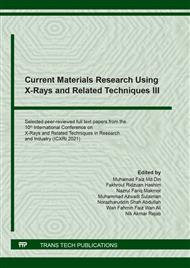p.159
p.165
p.171
p.177
p.185
p.190
p.196
p.202
p.208
Influence of Feldspar Addition on the Properties of CaCu3Ti4O12 Ceramic
Abstract:
The colossal dielectric permittivity of calcium copper titanate (CaCu3Ti4O12, CCTO) provides a vast potential in miniaturizing electronic devices but become limited due to high dielectric loss. Hence, feldspar was introduced to reduce the dielectric loss and fill in the air gap of CCTO during the sintering process. The CCTO powder was prepared by the solid-state reaction method. The study focused on characterizing pure and feldspar added CCTO properties on phase formation and dielectric properties. The raw materials were weighed, followed by stoichiometric ratios for pure CCTO. While the addition of feldspar was added using a weight percentage ratio of 1%, 3%, 5%, 7% and 10%. The mixed powders were ball mixed for 24 hours using dry mixing. The mixed powder was calcined at 900°C for 12 hours and then pressed into a pellet with 6 mm diameter, then sintered at 1040°C for 10 hours. The X-ray Diffraction (XRD) machine and impedance analyzer were utilized to observe the phase formation and dielectric properties of the samples prepared. A single phase of CCTO was obtained after the sintering process except for pure CCTO and 1wt% of feldspar addition, and it still has remaining CuO in the ceramic. Even though feldspar can reduce the dielectric loss of the CCTO from 0.6 (pure CCTO) to 0.4 (10 wt%) at 1 MHz, it also hard to maintain the high dielectric constant. The dielectric constant of 1wt% of feldspar addition was recorded the highest value, up to 4000 at 1 MHz, while the lowest dielectric constant owned by 10wt% of feldspar addition, ~700 at 1 MHz.
Info:
Periodical:
Pages:
185-189
Citation:
Online since:
January 2022
Keywords:
Price:
Сopyright:
© 2022 Trans Tech Publications Ltd. All Rights Reserved
Share:
Citation:


